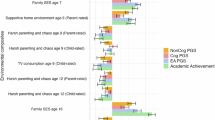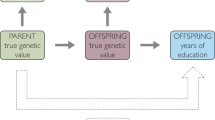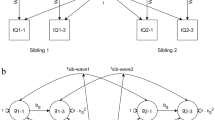Abstract
In a replication of Turkheimer, Haley, Waldron, D’Onofrio, Gottesman II (2003, Socioeconomic status modifies heritability of IQ in young children. Psychological Science, 14:623-628), we investigate genotype–environment (G × E) interaction in the cognitive aptitude of 839 twin pairs who completed the National Merit Scholastic Qualifying Test in 1962. Shared environmental influences were stronger for adolescents from poorer homes, while genetic influences were stronger for adolescents from more affluent homes. No significant differences were found between parental income and parental education interaction effects. Results suggest that environmental differences between middle- to upper-class families influence the expression of genetic potential for intelligence, as has previously been suggested by Bronfenbrenner and Ceci’s (1994, Nature-nurture reconceptualized in developmental perspective: a bioecological model Psychological Review, 101:568-586) bioecological model.



Similar content being viewed by others
References
Brofenbrenner U., Ceci SJ (1994) Nature-nurture reconceptualized in developmental perspective: a bioecological model. Psychol Rev 101:568–586
Button TMM, Scourfield J, Martin N, Purcell S., McGuffin P (2005) Family dysfunction interacts with genes in the causation of antisocial symptoms. Behav Genet 35:115–120
Guo G, Stearns E (2002) The social influences on the realization of genetic potential for intellectual development. Social Forces 80:881–910
Jensen AR (1998) The g factor: the science of mental ability. Preager,Westport, CT
Johnson W, Krueger RF (2005) Higher perceived life control decreases genetic variance in physical health: evidence from a national twin study. J Pers Soc Psychol 88:165–173
Loehlin JC, Nichols RC (1976) Heredity, environment, and personality: a study of 850 sets of twins. University of Texas Press, Austin, TX
Martin NG, Jardine R, Eaves LJ (1984) Is there only one set of genes for different abilities? A reanalysis of the National Merit Scholarship Qualifying Test (NMSQT) data. Behav Genet 14:355–370
Muthén LK, Muthén BO (1998–2004) Mplus user’s guide 3rd edn. Muthén & Muthén, Los Angeles, CA
Nichols RC, Bilbro WC (1966) The diagnosis of twin zygosity. Acta Genetica et Statistica Medica 16:265–275
Purcell S (2002) Variance components models for gene-environment interaction in twin analysis. Twin Res 5:554–771
Rowe DC, Jacobson KE, van den Oord E. (1999) Genetic and environmental influences on vocabulary IQ: parental education level as a moderator. Child Dev 70:1151–1162
Rowe DC, Vesterdal WJ, Rodgers JL (1999) Herrnstein’s syllogism: genetic and shared environmental influences on IQ, education, and income. Intelligence 26:405–423
Scarr S (1992) Developmental theories for the 1990s: development and individual differences. Child Dev 63:1–19
Scarr S. (1981) Race, social class, and individual differences in IQ: new studies of old issues. Erlbaum, Hillsdale, NJ
Shanahan MJ, Hofer SM (2005) Social context in gene-environment interactions: retrospect and prospect. J Gerentol: SERIES B 60B:65–76
Turkheimer E, Haley A, Waldron M, D’Onofrio BM, Gottesman II (2003) Socioeconomic status modifies heritability of IQ in young children. Psychol Sci 14:623–628
Turkheimer E., Gottesman II (1991) Individual differences and the canalization of human behavior. Dev Psychol 27:18–22
U.S. Department of Commerce, Bureau of the Census. (1960) General population characteristics. U.S. Government Printing Office, Washington, D.C.
van den Oord E, Rowe DC (1997) An examination of genotype–environment interactions for academic achievement in an U.S. longitudinal survey. Intelligence 25:205–219
Author information
Authors and Affiliations
Corresponding author
Additional information
Edited by Stacey Cherny
Rights and permissions
About this article
Cite this article
Harden, K.P., Turkheimer, E. & Loehlin, J.C. Genotype by Environment Interaction in Adolescents’ Cognitive Aptitude. Behav Genet 37, 273–283 (2007). https://doi.org/10.1007/s10519-006-9113-4
Received:
Accepted:
Published:
Issue Date:
DOI: https://doi.org/10.1007/s10519-006-9113-4




